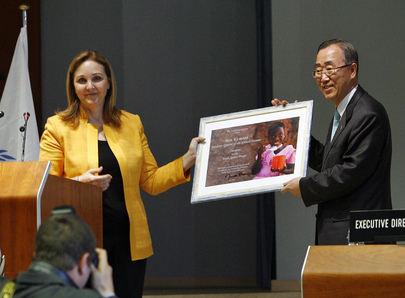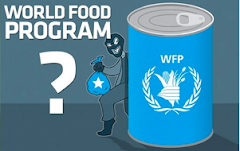By Matthew Russell Lee
UNITED NATIONS, August 22 -- The son in law of UN Secretary General Ban Ki-moon, Siddarth Chatterjee, had used threats of legal action to force the removal from the Internet of comments that he may have gotten his promotion with the UN Office of Project Services in Copenhagen due to nepotism, Inner City Press has learned.
In preparing its exclusive August 14 article on nepotism at the UN and Ban's position on and in it, Inner City Press ran across an article in the Indian Star online, which cited Inner City Press' previous piece on Chatterjee's promotion with the UN in Iraq. Recently, that Indian Star article and comments were taken off the Internet -- following a threat from Chatterjee and then by his India-based lawyer. Click here for the now-empty page.
Free press advocates express concern at the threats, noting that in such matters "the cover-up is always worse that the crime," and demand that Ban Ki-moon rebuke and renounce them. But will it happen?
Here for the record, and as requested by press press advocates in several continents, are comments which were on the Indian Star page which Ban's son in law, not stopped and presumably encouraged by Ban, got removed from the Internet by legal intimidation:
(Replied: Saturday, May 02, 2009, 06:05 am EST)
Interesting indeed. Some of us have, until very recently, had the misfortune of being exposed to this man, in a professional sense, in Iraq. Spineless is a very appropriate term to use in describing this individual. There are more, but few are fit for publication. He is, indeed, a discredit to India, the Indian Army, and now the UN (where, incidentally, he has recently moved on significant promotion - despite already being totally over-promoted in the opinion of all that know, and have to work with, him). The recent recruitment of this man to the United Nations Office of Project Services in Copenhagen is yet another example of the ineptitude, nepotism and corruption which is so prevalent within the UN system, even at the highest levels (in this case, within UNOPS). But those in Baghdad are delighted that UNOPS has taken him away from Iraq all the same.
It is a shame. And it would appear people are still being fooled.
and Posted: Saturday, February 28, 2009, 06:34 am EST
SANDHAYA AGARWAL (India)
Siddharth Chatterjee is a spineless man .He could not even pass the staff exams in Indian Army ... IT IS A SHAME THAT United Nations... GET FOOLED
After the Indian Star article and its comments went offline, they still remained available in the cache of Google and other search engines. Ban's son in law's lawyers made more legal threats -- "this is round two of the Bans and Google," said one observer of plans by the UN to get Inner City Press removed from Google News, click here for the most recent -- to get it out of cache.
Now even that censorship of questions of nepotism within Ban's UN has been accomplished -- click here for the now empty cache page.
Siddarth Chatterjee a public figure, and thus his legal threats are spurious, even an abuse of process. He is the son in law of the UN Secretary General, he was awarded a job at the UN's D-2 level (see below. Now, after refusing to answer Inner City Press' repeated questions referred by Ban's Spokesperson's Office if Chatterjee is a D-2 or a D-1, UNOPS tells other journalists that he is a D-1, in order to forestall other media coverage. Will it work?

UN's top lawyer O'Brien and Ban Ki-moon, legal threats of son in law not shown
Most recently, UNOPS in Copenhagen has told a Nordic newspaper what Chatterjee is a D-1, without explaining that the post was described by UNOPS' deputy director, in writing, as a D-2 post:
From: Vitaly VANSHELBOIM
Sent: 03 March 2009 11:09
To: UNOPS - EMO
Subject: Welcome to the new mailgroup
As you know, yesterday EUO and MEO formally merged into a new regional office called EMO (Europe and the Middle East) based in Copenhagen...I will be acting Regional Director of EMO until we have recruited a “permanent” replacement. In response to our advertisement for the D-2 regional director job, we received some 130 applications. Five candidates were short-listed for interviews: four were interviewed last Friday and the last interview is scheduled for Thursday this week. We’d like to make a decision by mid-March.
So even assuming that, as in Iraq, the UN decided even if only belatedly to keep Mr. Chatterjee a level below the grade of the post they awarded him, that is only being done to discourage press coverage of nepotism.
Even this raises questions of whether Ban, who came into the UN system promising reform and to run things cleanly, is due to his relatives' promotions so paranoia and angry about questions of nepotism that he has a conflict of interest in dealing with charges of nepotism against others in the UN, for example his own envoy to the Congo Alan Doss -- click herefor that.
Inner City Press broke the story about Alan Doss asking the UN Development Program for "leeway," to bend hiring rules and give his daughter Rebecca Doss a job in UNDP's Regional Bureau for Asia and the Pacific leading to a "man bite man" incident which was the focus of other media's follow up coverage. After Inner City Press' story about Ban and nepotism early on August 14, Ban's Deputy Spokesperson wrote to Inner City Press that:
From: okabe@un.org
To: matthew.lee@innercitypress.com
Sent: 8/14/2009 7:57:02 A.M. Eastern Standard Time
Subj: your latest entry
What I said was that queries on the biting incident should be directed to the NY County DA Office.
On the allegations, we take the matter very seriously.
"The Secretary-General is aware of the situation. He has been assured that a thorough independent investigation is underway, He takes this matter very seriously, and expects to see a report upon his return to NY."
Ban Ki-Moon returned to New York from his South Korea vacation and delivered prepared remarks at a World Humanitarian Day event in the UN's visitors' lobby on August 19. He took no questions. On August 21, after waiting two days, Inner City Press asked Ms. Okabe if Ban had as he expected now received the report on nepotism, and what would he do about it?
Ms. Okabe answered that although Ban had returned to New York, he had gone on leave again. So finally, what will he do?
Footnotes: in the course of legally threatening the Indian newspaper -- but not U.S. based Inner City Press -- it was argued that the Indian Star report which triggered the two comments Chatterjee and Ban did not like was "based only on a blog." The response was that Inner City Press is better read, at least online, than the Indian newspaper they threatened.
On that, Reuters of August 21 reported that "U.N. officials also complain bitterly about the indefatigable bloggerMatthew Lee, whose website Inner City Press regularly accuses Ban and other U.N. officials of hypocrisy and failing to keep their promises to reform the United Nations and root out corruption." Later, a telling second phrase was added: "(Some U.N. officials accuse Lee of not always getting his facts right, but his blog has become unofficial required reading for U.N. staffers around the world.)"
Ironically, on August 20 a UN under secretary general approached Inner City Press about the anti-Ban memo by Norwegian deputy permanent representative Mona Juul, having "just read it on your blog." For all of Ms. Juul's criticism of Ban, from Myanmar to Sri Lanka to climate change, Juul missed the nepotism and family connection angle. Her husband Terje Roed Larsen works for Ban, as another of his Under Secretaries General who has refused to make any disclosure of his finance or to answer Inner City Press' questions about them.
This is run for the proposition that as well as being a nepotism cover up scandal, this is a story about new media. Ban and his son in law have lawyers threaten ill-read newspapers for daring to carry a report based on what they call the "blog" Inner City Press and two resulting comments. They urge what they view as "real" or mainstream media not to cover stories which are broken by Inner City Press -- which, for example, had the world exclusive, acknowledged on Associated Press and in Japan media amog others, of the final draft of the Security Council's North Korea sanctions.
Inner City Press, which writes more about Myanmar than other UN based correspondents, was never even told of the opportunity, given to others, to accompany and report on Ban's ultimately failed trip there. Some say that in all this, Ban is being ill-advised by those around him. The question remains: is this anachronistic media strategy of cover up, deployed by Team Ban, working? Watch this site.




